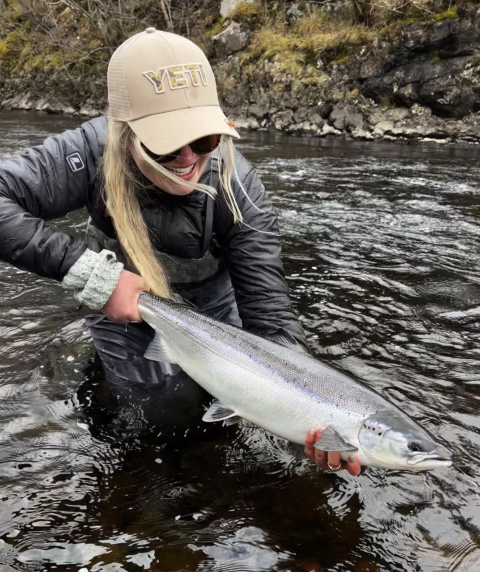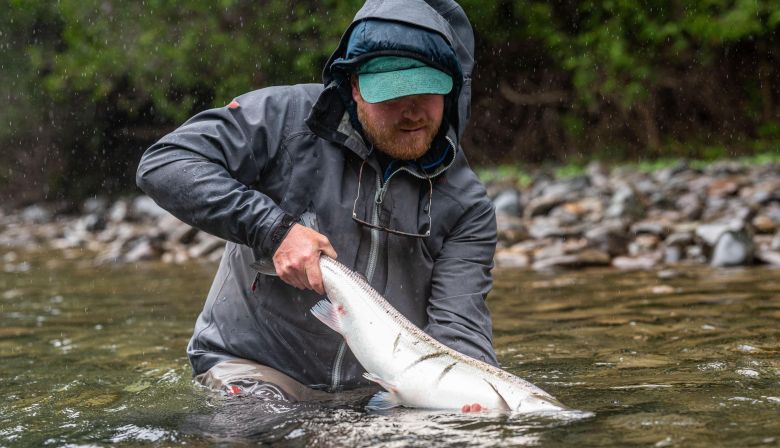
Subscribe & stay up-to-date with ASF


If you’re seeking an unparalleled fishing and outdoor experience, look no further than Quebec’s Gaspé Peninsula.
During a stop to purchase some striper flies All Points Fly Shop – https://allpointsflyfishing.co… – in South Portland, Maine last year, I had a conversation with owner Josh Thelin. Josh is also the head guide at Lakewood Camps, where we have spent time together on the banks of the Rapid River. Our discussion revolved around the common belief that Atlantic salmon fishing is inaccessible due to high costs, challenges in overcoming private access, and the idea that the best waters lie far away in places like in Labrador or Norway.
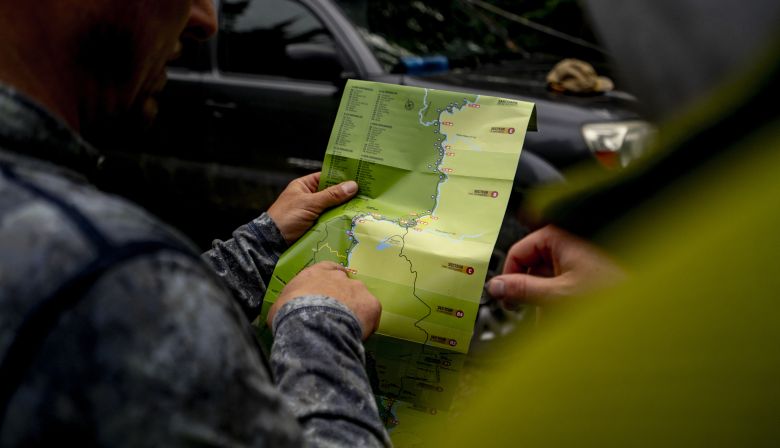
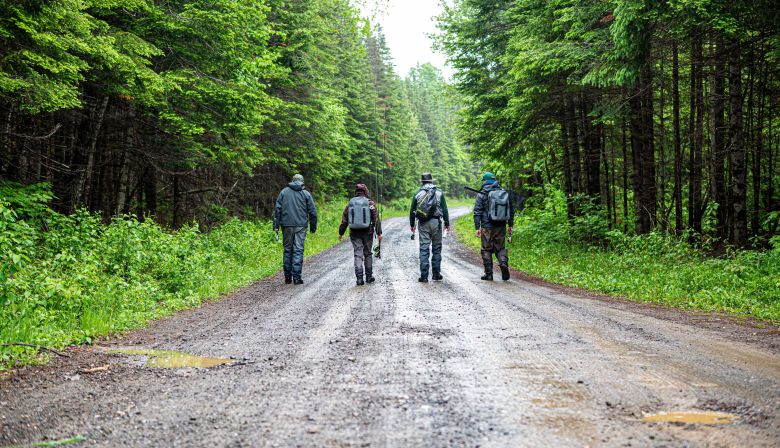
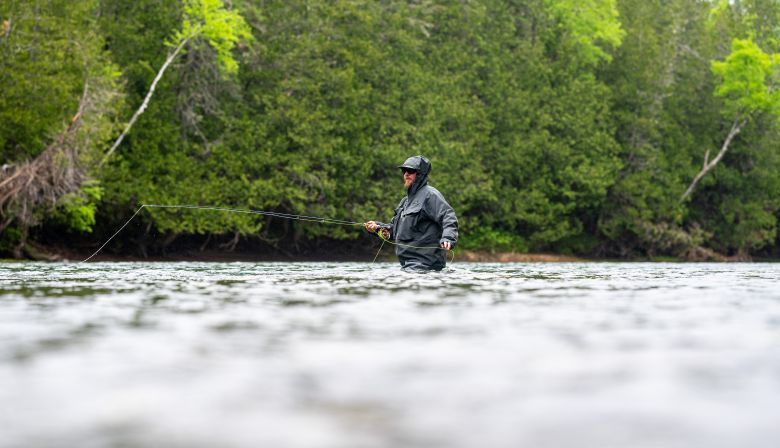
Our journey was not without its challenges. From navigating road closures caused by beaver dams to enduring torrential rain and a lengthy 12-hour drive, we faced it all. But every struggle was eclipsed by our remarkable outcome. Over four unforgettable, rain drenched days on the river, we discovered not only a thriving fishery but also a vibrant, passionate community. Everywhere we turned, we encountered enthusiastic people who welcomed us with open arms. Among them were the inspiring minds behind the Hooké – https://hooke.ca/ – fishing brand, whose presence added an extra touch of magic to our adventure.
I’ll leave the rest of the story to be told through the captivating visuals. Stay tuned for the upcoming winter edition of the Atlantic Salmon Journal, where we’ll delve deeper into our unforgettable experience!
Best regards and tight lines!
Peter

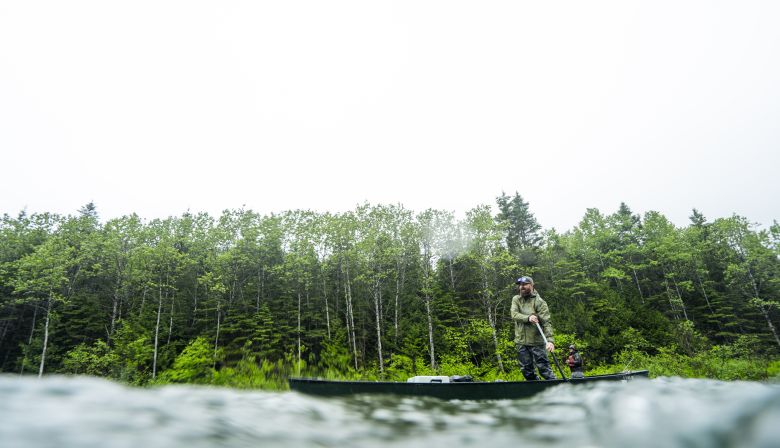

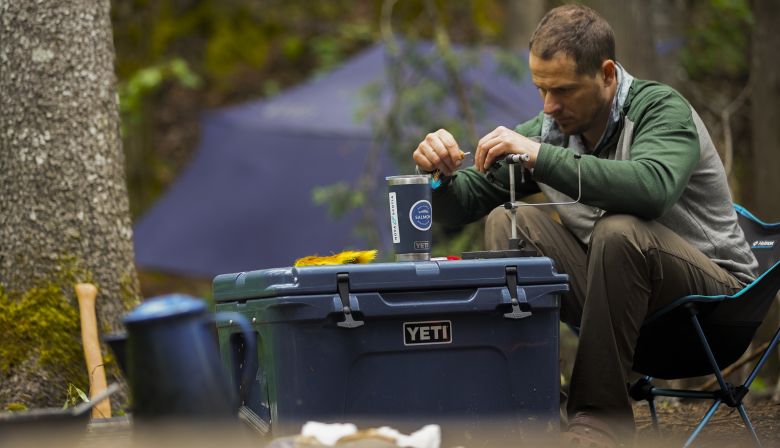
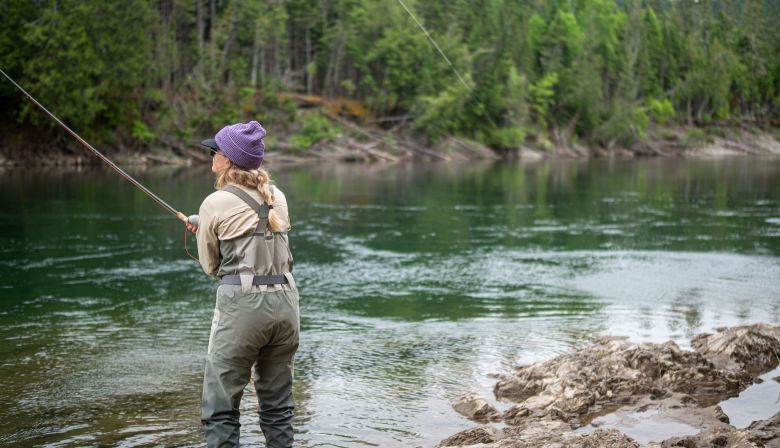
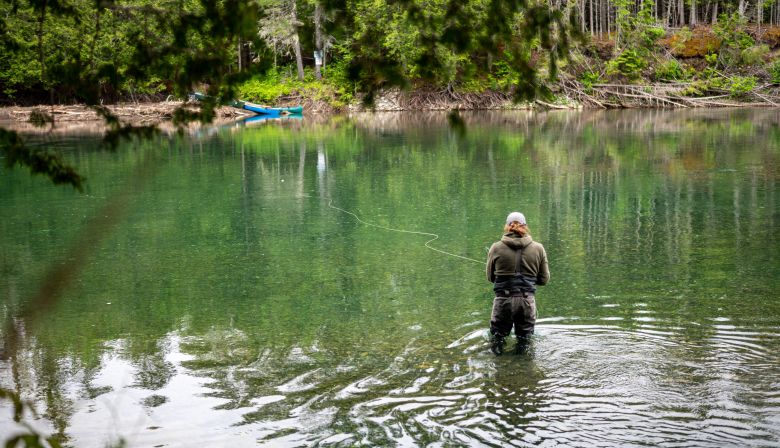
Serge Collin, New Brunswick Program Director, reports:
Click here to see the Dungarvon fish barrier report.
Click here to see the Northwest Miramichi fish barrier report.
Throughout the spring the Gespe’gewa’gi Institute of Natural Understanding (GINU) conducted weekly water chemistry sampling to monitor pH levels and their potential impact on out-migrating smolts. Low pH values can lead to aluminum binding to the gills, hindering smoltification and affecting survival. This research is part of a collaborative effort involving INRS, DFO, and the Quebec Wildlife Ministry. The results of this study will be published in 2024.
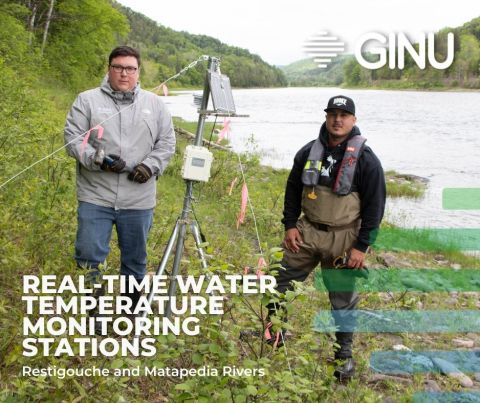
Additionally, GINU has installed two real-time water temperature monitoring stations along the Restigouche and Matapedia Rivers. These stations provide continuous updates on both air and water temperatures every thirty minutes, and the data is accessible on GINU’s website. These monitoring stations have been in operation since 2017.
For more information on GINU and their important work, please visit their website here.
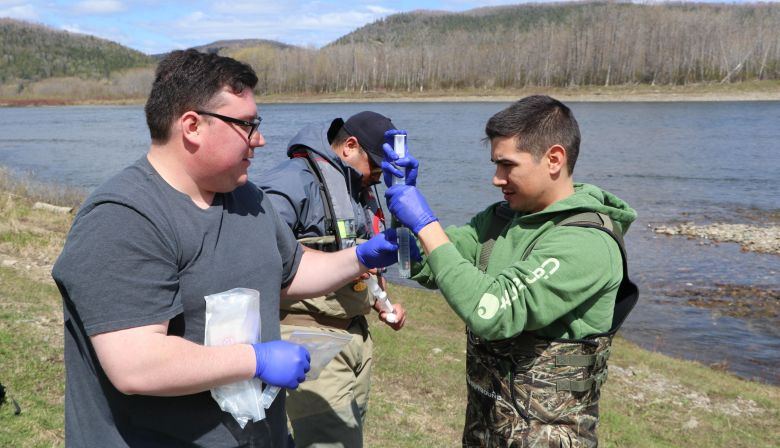
Charles Cusson, Quebec Program Director, reports:
For 343 years, the “Seigneurie de la rivière Madeleine” which includes the lower sector of the Madeleine river, situated on the north shore of the Gaspé peninsula, was a treasured playground reserved for a small group of illustrious people. Now that this area is accessible to the general public, Martin Silverstone and I had the chance to visit the site in preparation for a feature that will soon appear in the Atlantic Salmon Journal.
We were able to exchange views with several stakeholders on the subject of the socio-economic contribution the opening of this sector and the presence of SÉPAQ (who have been delegated to manage the area) will bring from outdoor activities such as salmon fishing and hunting. In general, the fact that local residents and Quebecers from other regions can now enjoy, explore, fish and hunt this territory is viewed in a positive light.

A worrisome trend is emerging on certain rivers in Quebec such as the York,Dartmouth, Saint-Jean, Matane and Bonventure rivers. Many anglers are not reporting their releases, which has forced salmon river managers to take action. See press release here.
As of June 19, SOGERM (Société de gestion de la rivière Matane) published the fact that 64 large salmon crossed the fishway. 95 large salmon had crossed the pass upstream on the same date in 2022.
The Moisie River Protection Association (APRM) reports as of June 18, for the area it manages, 26 catches have been recorded cumulatively since June 9, including 19 releases.
A recent burst of water created excellent angling conditions on the Causapscal River. 104 catches, including 60 releases, have been declared to date. The Matapédia is off to a slower start with 22 releases recorded through June 20. Like other rivers, traffic is on the rise this season, there are already 1,722 fishing days sold compared to 1,453 during the same period in 2022.

Depuis 343 ans, le secteur de la Seigneurie de la rivière Madeleine était un paradis réservé à un petit groupe de personnages illustre. La fin de semaine dernière, Martin Silverstone et moi avons eu la chance de visiter les lieux en préparation d’un reportage qui paraitra prochainement dans l’Atlantic Salmon Journal, publication de renom de la Fédération du saumon atlantique (FSA).
Nous avons pu échanger avec plusieurs intervenants du milieu sur le sujet de l’apport socioéconomique que l’ouverture de ce secteur et la présence de la SÉPAQ amèneront aux activités sportives telles la pêche au saumon et la chasse. En règle générale, le fait que les citoyens de la région et les Québécois d’ailleurs peuvent maintenant jouir de ce territoire est perçu de façon positive.
Sur les rivières du Grand Gaspé, Bonaventure et Matane, il y a une tendance inquiétante qui se manifeste. Les pêcheurs, en grande partie, ne font pas la déclaration de leurs remises à l’eau, ce qui a forcé les gestionnaires de rivière à saumon d’agir. Cliquer l’hyperlien ci-dessous pour en savoir plus.
lien ici
En date du 19 juin, la SOGERM (Société de gestion de la rivière Matane) a publié le fait que 64 grands saumons ont franchi la passe migratoire. 95 grands saumons avaient franchi l’amont de la passe à pareille date en 2022.
L’Association de protection de la rivière Moisie (APRM) fait rapport en date du 18 juin, pour la zone qu’elle gère, 26 prises ont été enregistrées cumulativement depuis le 9 juin comprenant 19 remises à l’eau.
En date du 20 juin, la rivière Causapscal a bénéficié d’un coup d’eau récemment qui a permis aux pêcheurs de vivre des moments spectaculaires dus à la présence accrue de Salmo salar. 104 prises dont 60 remises à l’eau ont été déclarées à ce jour. La Matapédia connait un début plus lent avec 22 remises à l’eau enregistrées jusqu’au 20 juin. Comme d’autres rivières, l’achalandage est la hausse cette saison, il y a déjà 1 722 jours pêche vendue comparativement à 1 453 pendant la même période en 2022.
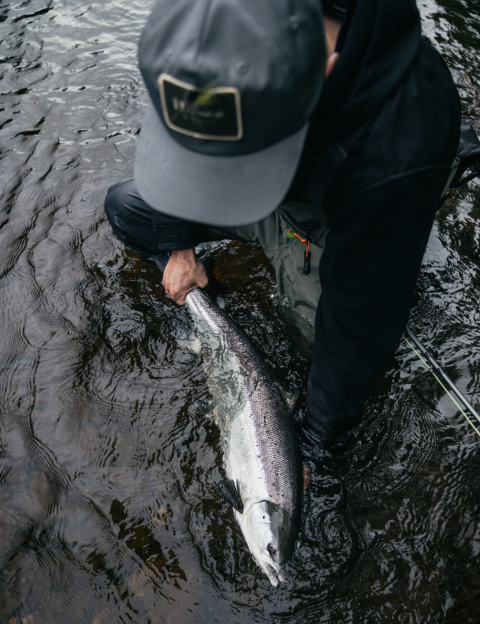
Martin Silverstone, ASJ Editor, reports:
The Causapscal River is an early season favourite for salmon anglers. From late May onwards fishers will flock to this tributary of the Matapedia to cast for salmon that have been known to reach up to 55 pounds. The day Charles Cusson, Nathan Wilbur and I visited the river this week we met Gabriel Ouellette and Bruno Legault at Bateau Pool. Ouellette, who I had met by chance in Riviere Madeleine a few days earlier, had released a salmon earlier in the day. His fishing partner, Bruno Legault had also released a salmon, his first ever! We shared a laugh of how he may have caught his first Atlantic salmon, but it was Bruno who was now seriously hooked on salmon angling. As a matter of fact, the two anglers left us to get some sleep before fishing the Rimouski River the next day.
It was Nathan’s first time on the Causapscal and we were able to visit The Falls pool where we saw salmon leaping up the waterfall. Some made it but some fell back, to try yet again. No wonder the Causap salmon are known for their strength and power.

Dès la fin mai, plusieurs pêcheurs se dirigent vers cet affluent de la Matapédia pour pêcher des saumons dont on sait que certains spécimens jusqu’à 55 livres reviennent à leurs rivières natales. Charles Cusson, Nathan Wilbur et moi avons visité ce cours d’eau cette semaine. Nous avons rencontré Gabriel Ouellette et Bruno Legault a la fosse Bateau Pool. Ouellette que j’avais rencontré par hasard à Rivière, Madeleine quelques jours plus tôt avait relâché un saumon plus tôt dans la journée. Son partenaire de pêche, Bruno Legault avait aussi relâché un saumon, son tout premier ! Nous avons rigolé du fait qu’il a peut-être attrapé son premier saumon, mais que dorénavant, Bruno était maintenant sérieusement atteint d’une saumonite aigüe pour la vie.
C’était la première fois que Nathan visitait la Causapscal et nous avons pu visiter la fosse « Falls » où nous avons observé les saumons qui sautaient la chute. Certains l’ont fait, mais certains ont échoué. Pas étonnant que les saumons de la Causap soient connus pour leur force et leur puissance.
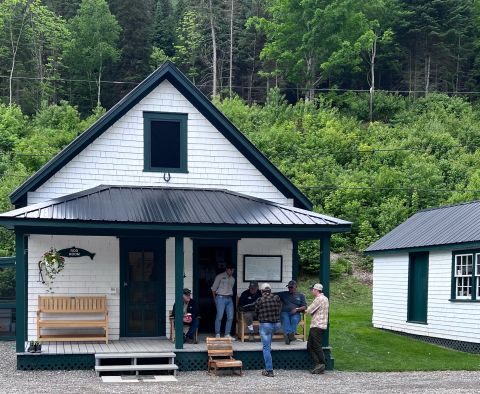
Roy Parker, Vice President Pictou Rivers Association Reports:
The Pictou County Rivers Association (PCRA) is excited to share their successful operation of the Fish Friends Program in Pictou County classrooms during 2023. A total of 21 aquariums were set up, with at least one tank in each of the 14 elementary schools in the county. Some schools even had multiple aquariums, allowing for greater student engagement.
In early March, temperature-controlled aquariums were installed in the classrooms and filled with eyed salmon eggs. Through this hands-on experience, students learned about the fascinating life cycle of fish, as they observed the eggs develop, hatch, and grow into free-swimming fry. As the school year progressed, the students had the opportunity to visit local rivers and release their fish into their native streams.
PCRA volunteers captured adult salmon from the West River in October 2022. These fish were transported to the NS Department of Fisheries and Aquaculture hatchery in Frasers Mills, where they were spawned and then released back into the West River. The salmon eggs were incubated at the hatchery until they were ready to be stocked into the classroom aquariums.
Starting in early June, a PCRA intern visited each school, transferring the fish to transport pails and transporting them to the West River. The students were then taken to the river site, where each child had the opportunity to release their own container of fish into the river.
This year, the students released over 2000 salmon fry into the West River, marking another successful year for the Fish Friends Program in Pictou County
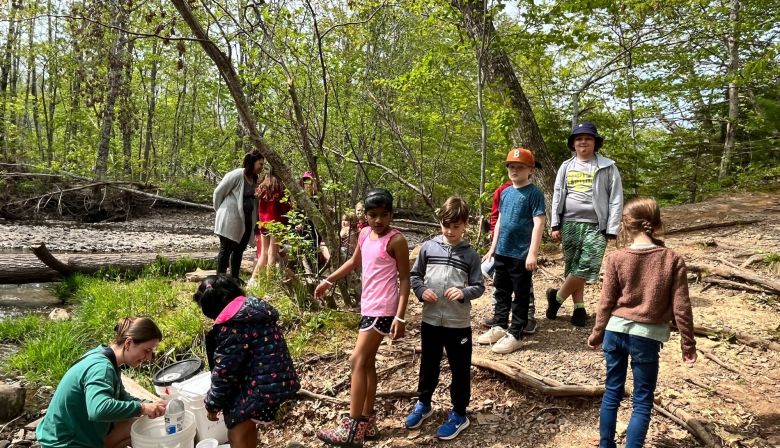
Gavin Scott, Project Manager for the Maritime Aboriginal Peoples Council Reports:
In the Northern Minas Basin, just west of Truro, Nova Scotia, the Maritime Aboriginal Peoples Council (MAPC) and their Salmon Comparative Assessment Project have completed an exciting phase of their study: alevin emergence. Over the past months, the team closely monitored the in-situ incubation of 2500 endangered Inner Bay of Fundy Atlantic salmon eggs in three river systems: Debert River, Folly River, and Portapique River. The project aims to evaluate the emergence timing and overall rearing quality of these rivers in comparison to other systems in the province.
The alevin emergence occurred between the first week of May and the first week of June. As the alevin reached full development, the incubation baskets were removed, and the remaining fry were released by the dedicated MAPC staff. During this four-week period, the Atlantic Water Network and Datastream joined the team in the field to assist with the release efforts at each incubation site. The Portapique Watershed site proved to be the most successful, with over 50% (272 out of 500) of the eggs successfully hatching. This marks the highest survival rate MAPC has achieved in their four years of egg incubation across all sites. The team will return to each site in September to conduct electrofishing surveys, hoping to observe a thriving population.
For any questions or general inquiries about the project, please feel free to contact salmon@mapcorg.ca
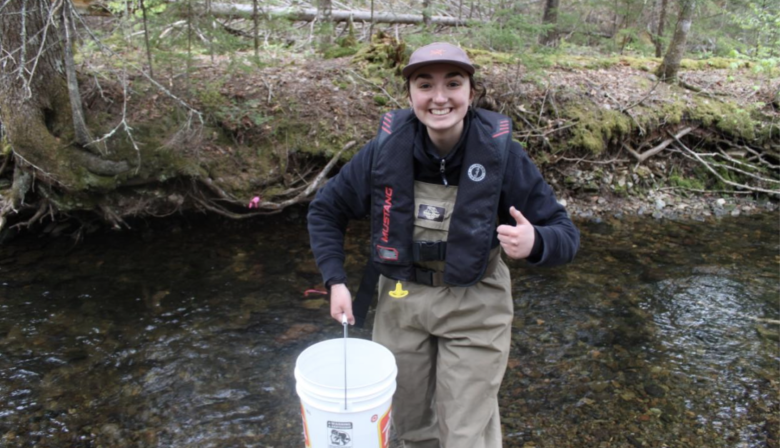
Don Ivany, Newfoundland and Labrador Program Director Reports:
Recent heavy rain in Newfoundland and Labrador caused a significant rise in water levels, leading to limited angling opportunities on many rivers. However, the water levels have started to recede on some rivers, improving angling conditions. Despite cold water temperatures, anglers are reporting increased fish sightings and improved angling success on fishable rivers. On the Codroy River, Mike Bragg released a nice 10-12lb fish, and there are more fish in the Bay St. George Rivers. Although the water level at Big Falls on the Humber River remains high, fish are being seen and hooked.
In Central Newfoundland, water on the Exploits River is gradually receding, with the Bishop Falls area becoming fishable again. The Gander River’s water level is still high, but fish are expected to arrive soon. In Southern Labrador, the Forteau River has ideal water levels, but no fish have been reported yet. The Pinware River is still high, and the Eagle River is experiencing average flow without any fish sightings. DFO is expected to release fish counting results soon, and they are reinstalling counting fences that were damaged by the high water.
In other news, our Research Division successfully deployed three lines of receivers across the Strait of Belle Isle with the assistance of Heather Perry and Madelynn Richardson.
For more information and updates on Newfoundlands salmon returns, visit here.
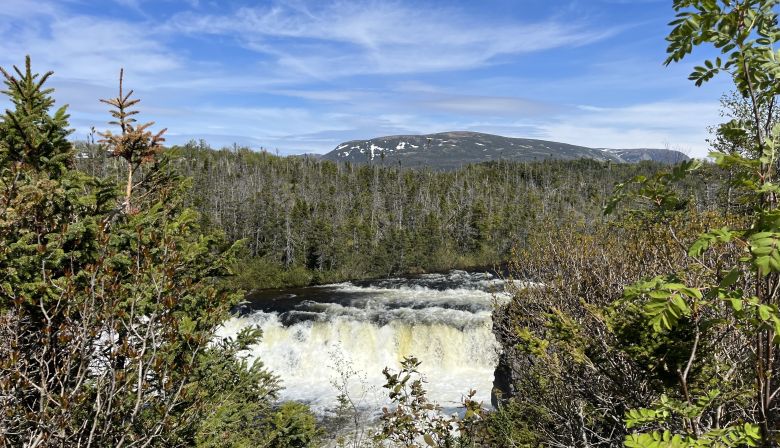
Heather Perry, ASF Biologist Reports:
Madelyn and I returned from Strait of Belle Isle which divides Labrador from Newfoundland on Saturday evening, with a total of 3 days spent on travel each way for just 1.5 days of work at Green Island Cove.
Loomis Way, the boat captain, and his two sons had already prepared all 58 lines and anchors for the north and south receiver arrays before our arrival. Our task was simply to attach the receivers 10m below the surface buoys upon our morning arrival. Although Loomis had initially planned to wait until his usual break from lobster fishing the following Sunday, we were eager to deploy the receivers promptly to capture the entire run and account for any potential weather delays.
After finishing the morning lobster fishing on Tuesday, Loomis took us out to deploy the first 40 receivers (20 on each line). Despite the deceptive sunshine, the presence of large icebergs floating through the strait served as a reminder to bundle up warmly.

The next morning, we were on the water at 7 am. Some of the icebergs had broken apart, creating a maze of large ice cubes near the shore. Across the strait, as we deployed the remaining 18 receivers, we looked back to see a thick curtain of fog hovering over the south side while the sun shone on us.
Back at Loomis’s home, his wife Brenda had prepared a hot breakfast and coffee for us. We caught up with the family and received recommendations for places to visit on our journey home, including the Viking settlement at L’Anse aux Meadows and the beautiful Green Garden Hill Trail in Gros Morne.
The receivers will be retrieved in August, and the detections of tagged kelt and smolt will provide valuable insight into their migration and survival across the Gulf of St. Lawrence.
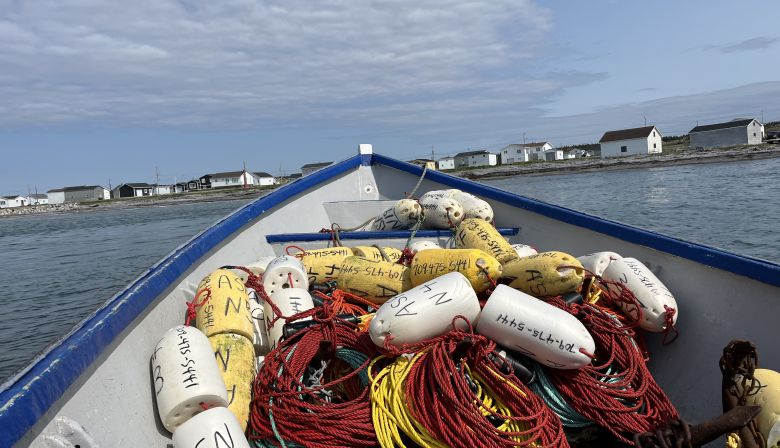
Maranda Nemeth, Maine Headwater Project Manager Reports:
The long-awaited completion of the Waltons Mill Dam removal and park project along Temple Stream is just weeks away. This project, which began in 2015, involved the full removal of the dam last year to restore passage for fish and enhance over 50 miles of cold-water habitat in the Kennebec watershed headwaters. Working closely with the community, ASF and our partners have not only restored the stream’s natural flow but also transformed the surrounding public space. The newly added overlook, pavilion, and trails provide easier access for families and visitors to enjoy the serene beauty of Temple Stream and observe wildlife. Landscaping work is nearing completion, and the park is set to reopen in July.
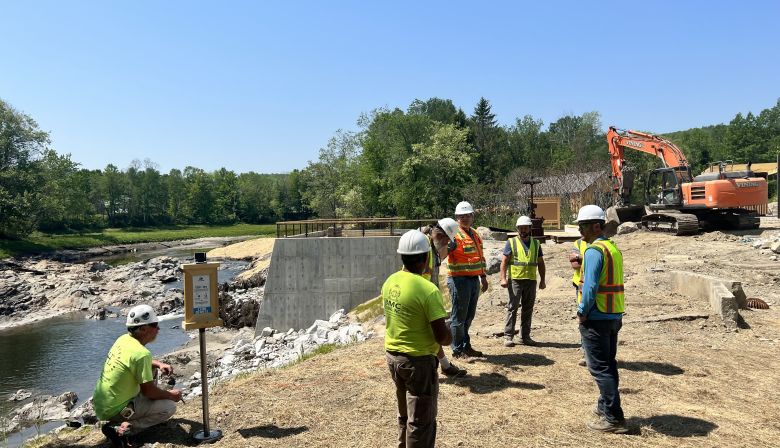
In collaboration with Maine Sea Grant and the Maine Department of Marine Resources (DMR), ASF organized a lecture and smolt meet-and-greet event in Dover-Foxcroft along the Piscataquis River. Biologists Justin Stevens and Pete Ruksznis shared their expertise on the life cycle of wild salmon, highlighting the 20 smolts that Pete brought from the USFWS hatchery. This unique opportunity allowed participants to observe and connect with these fish during their transition to adulthood. The event drew a virtual audience of 60 people and extended beyond its scheduled time due to engaging discussions and inquiries. Reflecting on the experience, Justin expressed his delight in witnessing the growing appreciation for salmon and their captivating nature among attendees.
In addition, ASF and The Nature Conservancy entered into a partnership agreement with the Town of Dover-Foxcroft concerning the Mayo Mill Dam on the Piscataquis River. The organizations aim to determine the next steps for the dam, and a feasibility report will be completed in the fall, after which the town will made a decision. For more information about the Mayo Mill Dam study, please visit here.

Jennifer Noll, Maine Department of Resources Scientist Reports on the Kennebec River:
A significant rain event occurred over the weekend, resulting in over 1.5″ of rainfall and causing the river to swell. Despite the relatively cool air temperatures for this time of year, the river temperature has risen to 17.3°C, which is 1.5°C lower than the temperature recorded last year on the same date. The river has experienced extremely high water levels following the rainstorm, with a discharge reaching almost 50,000cfs on June 19th. The current discharge level stands at 31,700cfs, which is very close to the highest recorded discharge level of 35,600cfs in 2008 (based on 37 years of data from USGS). Flow conditions are expected to decrease in the coming week, but more rain is forecasted.
Due to the high flow conditions, the fish lift has been fully operational until June 18th when it was shut down. It remains closed until the river discharge level decreases to 24,000cfs. During the recent period, 8 Atlantic salmon adults (2SW) and 0 grilse (1SW) were captured, bringing the total for the 2023 season to 92. Two recaptures were reported, likely originating from hatcheries. The nightly shutdowns of the projects have concluded since June 14th. The number of naturally reared fish returning this year is similar to the previous year’s run at this time. All captured salmon were released in the Sandy River, where the water temperature measured 13.5°C.

Jason Valliere, Maine Department of Resources Scientist, Reports on the Penobscot River:
Salmon returns remain steady, with a total of 1,149 recorded so far. However, temperature and river flow have been fluctuating. Currently, the water temperature is 61°F, and the flows have risen to over 40,000 cfs.
Shad and sea lamprey numbers have been lower compared to previous years, but this may change as conditions improve. The blueback herring run is nearing its end, with only a few thousand observed daily.
In other news, no new salmon have been reported this week due to challenging conditions caused by recent rain. Discharge has increased to over 700 CFS, and the water temperature stands at a cool 16°C. Despite the difficulties, sixteen new Atlantic salmon were captured, bringing the season total to 295.
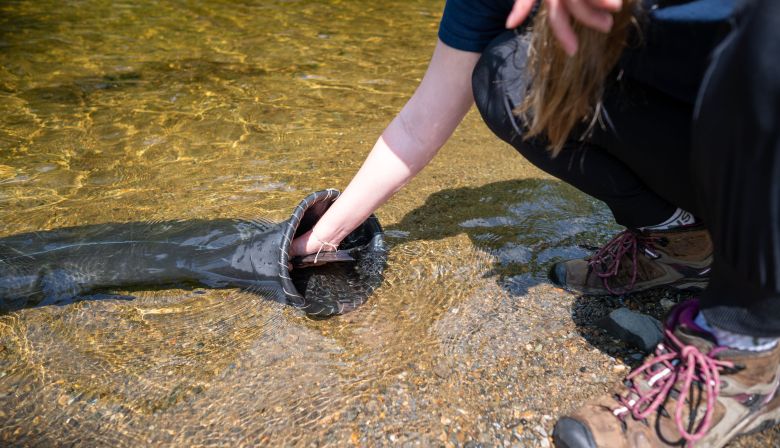
Lana Richardson Reports:
Atlantic Salmon in Scotland, Summer 2023, so far.
Scotland has been experiencing an exceptionally hot and dry summer, with air temperatures frequently exceeding 30 degrees Celsius. As a result, some fishing beats and entire rivers have chosen to suspend fishing temporarily or limit fishing to early mornings and evenings to alleviate pressure on the fish. Water temperatures have risen above 20 degrees Celsius, posing challenges for the fish and the reduced flows have led to less oxygenated water. Additionally, several Scottish rivers, particularly smaller spate rivers, are facing record low water levels this year.
Many salmon, including later spring runs and grilse, are currently congregating in river estuaries and tidal sea pools, awaiting sufficient rainfall to continue their journey upstream. In recent years, there has been a noticeable decrease in snowfall, even in higher-altitude areas. In the past, the snow would melt gradually, supplying cool water to the rivers during spring and early summer.
There is hope that Scotland will receive adequate rainfall during the remaining summer months to facilitate salmon migration and provide a comfortable environment for them in the rivers. Cool, clean, and fresh water is crucial to prevent health issues such as Saprolegnia. Unlike some regions, Scotland does not have specific laws prohibiting fishing under certain temperature or water level conditions (unless stated by specific fisheries or river boards). Therefore, anglers must be responsible and know when it is necessary to stop fishing in the best interest of the fish.
